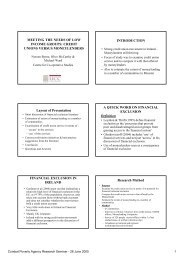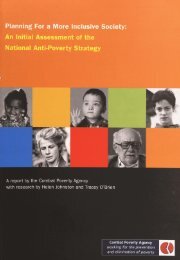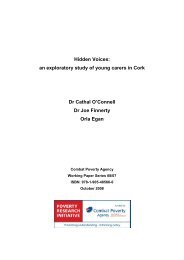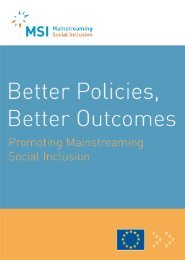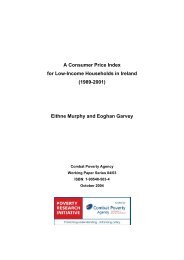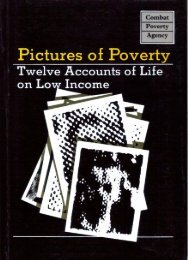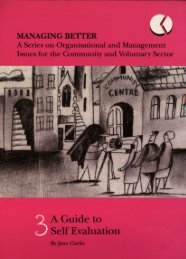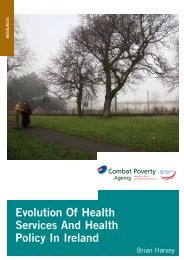The Distribution of Income in Ireland (2000) - Combat Poverty Agency
The Distribution of Income in Ireland (2000) - Combat Poverty Agency
The Distribution of Income in Ireland (2000) - Combat Poverty Agency
- No tags were found...
You also want an ePaper? Increase the reach of your titles
YUMPU automatically turns print PDFs into web optimized ePapers that Google loves.
84 <strong>The</strong> <strong>Distribution</strong> <strong>of</strong> <strong>Income</strong> <strong>in</strong> <strong>Ireland</strong>Table 7.4: Female Employment Rate by Male Earn<strong>in</strong>gs,1987-1994Husband's Position <strong>in</strong>Earn<strong>in</strong>gs <strong>Distribution</strong>Husband an employee <strong>in</strong> theFirst DecileSecond DecileThird DecileFourth DecileFifth DecileSixth DecileSeventh DecileEight DecileN<strong>in</strong>th DecileTenth DecileBelow MedianAbove MedianFemale EmploymentRate1987 199424.616.618.620.817.826.719.028.331.723.419.425.7Husband unemployed 20.130.845.745.043.743.247.542.042.938.128.541.739.816.7% Change1987-1994+25+ 175+ 141+ 110+143+78+121+52+20+22+115This change <strong>in</strong> the pattern <strong>of</strong> female employment might <strong>in</strong> itselfbe expected to reduce household <strong>in</strong>come <strong>in</strong>equality. To get acomplete picture <strong>of</strong> the contribution <strong>of</strong> female earn<strong>in</strong>gs tohousehold <strong>in</strong>come <strong>in</strong>equality, though, we also need to knowwhat was happen<strong>in</strong>g to the level <strong>of</strong> earn<strong>in</strong>gs <strong>of</strong> women <strong>in</strong> differenthouseholds over the 1987-1994 period. Compared to theway participation rates have evolved, this <strong>in</strong> fact reveals a verydifferent story. <strong>The</strong> greatest wage <strong>in</strong>crease was among work<strong>in</strong>gwomen married to men with above average earn<strong>in</strong>gs, for whomreal wages <strong>in</strong>creased by 17 per cent. In contrast, for womenmanned to men with below average earn<strong>in</strong>gs, real wages <strong>in</strong>creasedby only 2 per cent. Women employees married to unemployedmen actually saw their real weekly wage fall over thisperiod (though this is based on relatively few observations). 33^Lne^ l°, be CarefUl* """Pret<strong>in</strong>g *e wage figure for women marriedto unemployed men as the estimates are imprecise. This reflects the small+55-17Female Labour Force Participation and Inequality 85<strong>The</strong>se wage changes contributed substantially to the <strong>in</strong>crease <strong>in</strong>the correlation between spouses' earn<strong>in</strong>gs over the period.If the growth <strong>in</strong> part-time work was more prevalent amongworkers at the lower end <strong>of</strong> the distribution, the fall <strong>in</strong> realweekly wages for women married to unemployed men couldthen simply reflect an <strong>in</strong>creas<strong>in</strong>g proportion <strong>of</strong> these workerswork<strong>in</strong>g shorter weeks. However, the same pattern emergeswhen we look at hourly wages, with the real hourly wage forwomen married to high-earn<strong>in</strong>g husbands go<strong>in</strong>g up 30 percent, compared to 9 per cent for women married to low earn<strong>in</strong>ghusbands and once aga<strong>in</strong> a decl<strong>in</strong>e for women married to unemployedmen. <strong>The</strong> female earn<strong>in</strong>gs distribution itself becamemore unequal, with the ratio <strong>of</strong> the top to bottom decile <strong>of</strong> thefemale wage distribution <strong>in</strong>creas<strong>in</strong>g from 9.3 to 10.4 between1987 and 1994." <strong>The</strong> impact <strong>of</strong> <strong>in</strong>creas<strong>in</strong>g participation meansthat if we look at all wives, by contrast, we see a reduction <strong>in</strong>dispersion because there are significantly fewer with no earn<strong>in</strong>gsat all.This analysis identifies two channels whereby recent trends<strong>in</strong> female labour supply and wages would have worked to actually<strong>in</strong>crease household <strong>in</strong>come <strong>in</strong>equality. <strong>The</strong> first is that thewage growth among females has been most pronouncedamong women married to high earn<strong>in</strong>g husbands, so the correlationbetween male and female wages has <strong>in</strong>creased. This<strong>in</strong>creased correlation would tend to <strong>in</strong>crease household <strong>in</strong>comedispersion, other th<strong>in</strong>gs fixed. Secondly, the distribution <strong>of</strong> femalewages tends to be much more dispersed than that <strong>of</strong> maleworkers. As female earn<strong>in</strong>gs becomes a more important part <strong>of</strong>household <strong>in</strong>come the greater dispersion exhibited with<strong>in</strong> thedistribution <strong>of</strong> female earn<strong>in</strong>gs will tend to feed <strong>in</strong>to the distribution<strong>of</strong> household <strong>in</strong>come. <strong>The</strong> chang<strong>in</strong>g pattern <strong>of</strong> femalesample sizes on which the wage changes for this category <strong>of</strong> worker are calculated.A possible explanation for the faster <strong>in</strong>crease <strong>in</strong> earn<strong>in</strong>gs among womenmarried to men with above average earn<strong>in</strong>gs is the <strong>in</strong>crease <strong>in</strong> returns toeducation which have occurred over this period <strong>in</strong> <strong>Ireland</strong>, as described <strong>in</strong>Chapter 6. Given the tendency for couples <strong>of</strong> similar education levels tomarry we might expect the rise <strong>in</strong> return to skill to be reflected <strong>in</strong> fasterearn<strong>in</strong>gs growth for women married to high <strong>in</strong>come men.




